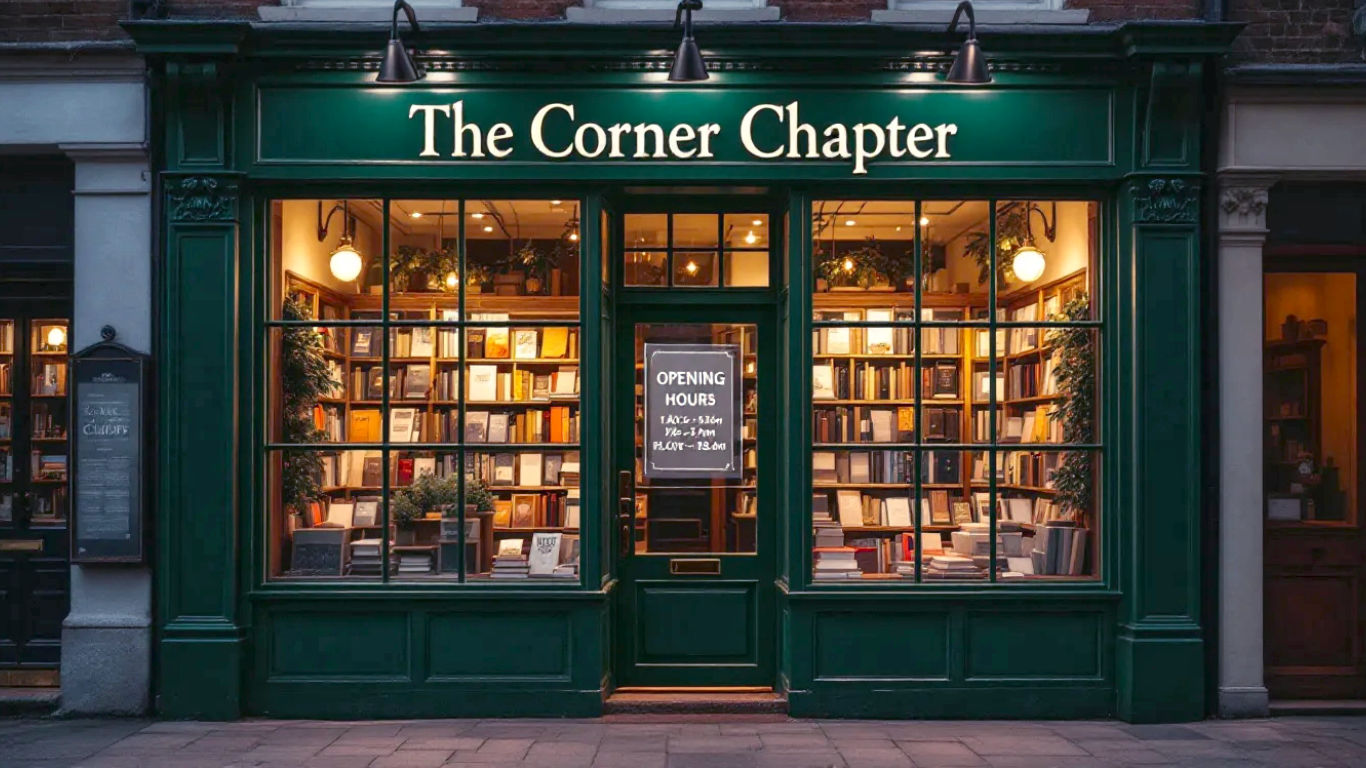The Importance of Clear Business Hour Signage
An essential guide for any British business owner. Learn why clear, accurate business hour signage is your most vital, yet overlooked, marketing tool.

This post may contain affiliate links. If you make a purchase through these links, we may earn a commission at no additional cost to you.
Imagine this. It’s a damp Tuesday afternoon, and you’ve just remembered you need to post a birthday card for your Nan. You make a dash to the local Post Office during your lunch break, weaving through the bustling high street, only to be met with a locked door and a darkened interior. You peer closer, squinting at a faded, handwritten note sellotaped to the glass. “Back in 5,” it says. But when was “5” minutes from? Ten minutes ago? An hour? A flicker of frustration bubbles up. You don’t have time to wait. Defeated, you turn away, the card still in your bag. Nan’s birthday will have to be a day late.
This small, everyday annoyance is something we’ve all felt. It’s the silent let-down of a business breaking its most basic promise: the promise of being there when it says it will be. That little sign on the door, the one detailing the opening and closing times, is far more than just a list of numbers. It’s your first handshake with a potential customer. It’s a statement of reliability, a mark of professionalism, and one of the most powerful, yet frequently overlooked, tools in any business’s arsenal.
In this guide, we’re going to explore every nook and cranny of business hour signage. We’ll look at why a simple, clear sign can be the difference between a thriving local hub and a shop people walk right past. From the psychology of customer trust to the nitty-gritty of design and digital consistency, we’ll show you why getting your opening hours right isn’t just a tiny detail—it’s the bedrock of a great customer relationship.
The Psychology of the Humble Opening Hours Sign
At its heart, a business is a relationship built on trust. And trust, like a good cup of tea, is best when it’s straightforward, warm, and reliable. An opening hours sign is one of the first and most fundamental ways you start building that trust, often before you’ve even said hello.
Why Clarity Builds Instant Trust
When a customer sees a clear, professionally made sign with your hours, their brain quietly ticks a box. It says: “This place is organised. They care about their customers’ time. They are reliable.” This subconscious assessment is incredibly powerful. It sets a positive tone for the entire interaction.
Think about it. A clear sign removes uncertainty. The customer doesn’t have to guess, wonder, or feel anxious about whether you’ll be open. This mental ease, known in psychology as reducing cognitive load, makes them feel more comfortable and confident in their decision to engage with your business. They know the rules of engagement. They feel respected. In a world of digital noise and broken promises, that simple feeling of certainty is invaluable.
The Hidden Cost of Confusion: Frustration and Lost Sales
Now, let’s flip the coin. What happens when the sign is confusing, wrong, or non-existent? The opposite effect kicks in.
- Ambiguity Breeds Annoyance: A vague, handwritten sign (“Closed for lunch”) creates immediate frustration. The customer feels their time has been disrespected. They’ve made an effort to visit, and the business has met them with a shrug.
- Inaccuracy Destroys Trust: The worst sin of all is an inaccurate sign. If your sign says you open at 9:00 am but the lights are still off at 9:15 am, you’ve broken that initial promise. The customer doesn’t just feel annoyed; they feel misled. That negative feeling can be powerful enough to make them walk away and never come back. Worse still, they might share that negative experience online, turning one bad impression into a lasting digital stain on your reputation.
- No Sign at All is a Red Flag: A business with no hours listed can feel temporary, unprofessional, or even a bit dodgy. It suggests a lack of commitment and can deter customers who are looking for a reliable, long-term service provider.
This isn’t just about feelings; it’s about money. A frustrated potential customer is a lost sale. And in a competitive market, they’ll simply walk a few doors down to your competitor who made the effort to be clear and reliable.
Managing Expectations: The Key to Customer Satisfaction
Ultimately, your business hours sign is a tool for managing customer expectations. When you clearly state your hours, you are setting a boundary and making a promise. “These are the times we are here, ready and waiting to serve you.”
By fulfilling that simple promise, you start the customer relationship on a foundation of trust and respect. It shows that you understand their needs and have structured your business to meet them. This simple act of clear communication is one of the easiest and most effective ways to ensure customer satisfaction from the get-go.
The Tangible Business Benefits of Getting It Right
While the psychology is fascinating, the real-world impact of good signage is what truly matters to a business owner. Getting your opening hours right isn’t just about being polite; it’s a strategic decision that directly impacts your bottom line.
Boosting Footfall: The Sign as a Silent Invitation
Your opening hours sign acts as a constant, 24/7 marketing tool. For every person who walks past your shopfront after you’ve closed, that sign is doing one of two things:
- A Bad Sign: If the sign is unclear or unappealing, the passer-by might barely register it and forget your business exists.
- A Good Sign: If the sign is clear, well-designed, and easy to read, it plants a seed. The person thinks, “Oh, they’re open tomorrow from 10 am. I’ll pop back then.” It turns a missed opportunity into a future visit.
A clear sign gives potential customers the information they need to plan a visit. It empowers them to fit your business into their busy lives, dramatically increasing the chances they’ll walk through your door.
Building Loyalty, One Reliable Visit at a Time
Customer loyalty isn’t built on grand gestures. It’s built on a thousand tiny, consistent, positive experiences. Being reliably open when you say you will be is one of the most important of these small acts.
When customers know they can count on you, they stop thinking of you as just one of many options. You become their butcher, their bookshop, their café. This reliability removes friction from their lives. They don’t need to double-check or have a backup plan. This ease and dependability are what transform a one-time buyer into a loyal, repeat customer who recommends you to their friends and family.
A Real-World Example: The Tale of Two Bakeries
Let’s imagine two bakeries on the same high street in, say, York.
- Bakery A, “The Rolling Scone,” has a beautiful shopfront, but their hours are written in a swirly, hard-to-read font on a small sticker. They often open a few minutes late if the morning bake is running behind.
- Bakery B, “Reliable Rolls,” has a simpler shopfront, but features a large, clear, printed sign: “Mon-Sat: 8:00am – 4:00pm.” They make it a point of pride to have the doors open and the smell of fresh bread wafting out at 7:59 am every single day.
A new resident moves into the area. They try The Rolling Scone first, arriving at 8:05 am to find it still closed. Frustrated, they walk down to Reliable Rolls, which is open and buzzing. Where do you think they’ll go for their morning loaf from now on?
Reliable Rolls understands that their business isn’t just about selling bread; it’s about being a dependable part of their customers’ daily routine. Their clear signage is a reflection of that core business value.
Reducing Staff Interruptions and Improving Efficiency
Clear signage doesn’t just benefit customers; it benefits your staff and operations, too. Think of the time wasted by staff answering the phone to the most common question: “What time do you close?” Or the frustration of dealing with a customer who is banging on the door ten minutes after you’ve locked up, pointing at a sign with incorrect closing times.
When your hours are clear and consistent everywhere (on the door, on the phone’s answering machine, and online), these interruptions decrease dramatically. This frees up your team to focus on serving the customers who are actually in the shop, improving efficiency and creating a calmer, more productive work environment.
A Practical Guide to Creating the Perfect Business Hours Sign
Right then, we’ve covered the ‘why’. Now let’s get our hands dirty with the ‘how’. Creating an effective business hours sign isn’t complicated, but it does require a bit of thought. We can break it down into three key parts: design, content, and placement.
Part 1: Nailing the Design
The design of your sign is all about one thing: immediate clarity. Someone should be able to walk past, glance at it for two seconds, and know exactly when you’re open.
Readability is King: Choosing the Right Font and Size
This is not the time for fancy, artistic fonts that are hard to decipher.
- Choose a Sans-Serif Font: Fonts like Helvetica, Arial, Open Sans, or Lato are your best friends here. They are clean, simple, and incredibly easy to read from a distance. Avoid cursive or overly decorative scripts.
- Size Matters: The text needs to be big enough to be read comfortably from the pavement. You don’t want people pressing their noses against the glass to read it. As a general rule, the main times should have characters at least one inch high, but bigger is often better.
- Keep It Tidy: Don’t cram too much information together. Use clear spacing between lines and days to make the information easy to scan. A simple table format often works best.
The Power of Contrast: Making Your Sign Pop
For your sign to be legible, the text colour needs to stand out clearly against the background colour.
- Classic Combos: Black text on a white or yellow background, or white text on a black or dark blue background, are timeless for a reason. They offer the highest possible contrast.
- Brand Consistency: If you use your brand colours, make sure they have enough contrast. A light grey text on a white background, for instance, would be a disaster for readability. You can use online contrast checker tools to see if your chosen colours work well together.
Material Matters: From Vinyl Decals to Classic Painted Boards
The material you choose says something about your brand and affects the sign’s longevity.
- Vinyl Decals: These are a very common, affordable, and professional-looking option. They stick directly to the inside of your window or door glass. They look clean and are easy to update if your hours change.
- Hanging Signs or Plaques: A small, well-made sign made of wood, slate, or metal can add a touch of class and permanence. These are great for businesses aiming for a more traditional or premium feel, like a heritage pub or a bespoke tailor.
- Painted Signs: A professionally hand-painted sign is a beautiful, classic choice that evokes a sense of craft and tradition. While more expensive, it can become a real feature of your shopfront.
- Avoid Paper! The absolute last resort is a piece of A4 paper printed from your computer. It looks temporary, can get damaged by condensation, and fades in the sun, quickly making your business look unprofessional.
Part 2: What to Actually Write on Your Sign
Getting the content right is about providing all the necessary information without creating clutter.
The Essentials: Days, Times, and Contact Details
Your sign must, at a minimum, include:
- Days of the Week: List every day, even the ones you’re closed. It’s better to write “Sunday: Closed” than to omit Sunday entirely, as it removes any doubt for the customer.
- Opening and Closing Times: Use a consistent format. The 12-hour format (e.g., 9:00am – 5:30pm) is generally more common and easily understood in the UK than the 24-hour clock for retail.
- Business Name: While it might seem obvious, including your business name reinforces your brand.
- Contact Number/Website: Adding a phone number or website address is a great touch. It gives customers a way to get in touch if they have a query outside of your opening hours.
Here’s a great, simple format:
The Little Book Nook
Monday – Saturday: 9:30am – 5:30pm Sunday: Closed
www.thelittlebooknook.co.uk
Handling the Exceptions: Bank Holidays, Seasonal Hours, and Special Closures
The British calendar is full of Bank Holidays, and many businesses have different hours during summer or around Christmas. Don’t let your main sign become a lie during these times.
- Use a Temporary Notice: Have a smaller, secondary sign you can put up a week or two in advance of a Bank Holiday. It should be just as professional as your main sign. For example: “Please note we will be closed for the Bank Holiday on Monday, 26th August.”
- Adjustable Signs: Some signs have sections that can be easily changed, like a small slot for a “Closed” or “Open” panel, or even digital displays.
- Be Proactive: If you know you’ll be closing for a holiday or for renovations, put the notice up well in advance. It shows you’re thinking about your customers.
Adding a Human Touch: A Friendly Note Goes a Long Way
Your sign doesn’t have to be cold and robotic. A little bit of personality that matches your brand can be very effective. A café might add a line like: “Come in for a cuppa!” or a bike shop could say: “Open for all your cycling needs.” This small touch can make your business feel more welcoming and approachable.
Part 3: Prime Real Estate: Where to Place Your Sign
You can have the best-designed sign in the world, but if it’s in the wrong place, it’s useless.
The “Glance Test”: Finding the Perfect Eye-Level Spot
The best place for your main hours sign is almost always on your main entrance door, positioned at eye-level for the average adult. People naturally look at the door as they approach, so placing it here means it’s almost impossible to miss. They should be able to read it in a single, quick glance without having to search for it.
The A-Board Advantage: Capturing Pavement Traffic
An A-board, or pavement sign, is a fantastic secondary tool. It can be placed directly in the line of sight of people walking down the high street. While its main job might be to advertise a special offer, including your opening hours at the bottom is a brilliant way to reinforce that information and catch the eye of people who might not be looking directly at your shopfront. (Just be sure to check your local council’s regulations on A-boards!).
Beyond the Door: Unifying Your Hours in the Digital Age
In today’s world, your physical shopfront is only one of your business’s “front doors.” Your online presence is just as important, and if your information is inconsistent, you’re heading for trouble.
Your Digital Shop Front: Google My Business is Non-Negotiable
When someone wants to know your opening hours, what’s the first thing they do? They “Google it.” Your Google Business Profile (formerly Google My Business) is arguably your most important sign of all.
- Claim and Verify Your Listing: If you haven’t already, do this immediately. It’s free and gives you control over how your business appears on Google Search and Google Maps.
- Keep It Meticulously Updated: Your hours on Google must match the hours on your door. If they don’t, you will create frustrated customers. Google found that businesses with accurate hours get more direction requests and website clicks.
- Use the Special Hours Feature: Google makes it easy to set special hours for Bank Holidays or other events. Use this feature! It shows customers you are on top of your game.
Consistency is Key: Aligning Your Website and Social Media
Your opening hours should be easy to find on your own digital properties, too.
- Your Website: Don’t bury your hours on a hard-to-find contact page. The best practice is to have them clearly listed in the footer of every page of your website. This means no matter where a visitor lands, the information is right there.
- Social Media: If you use Facebook, Instagram, or other platforms, make sure your hours are correctly filled out in your profile information. A quick check once a month to ensure everything is aligned is a great habit to get into.
The Danger of Conflicting Information
Imagine a customer checks your website, which says you close at 5:30 pm. They arrive at 5:15 pm, only to find you’re closed. They point to your door sign, which says you close at 5:00 pm. In this scenario, it doesn’t matter who is right. You have already lost. The customer is angry, their trip has been wasted, and they now see your business as disorganised and unreliable. Consistency across all platforms is the only way to win.
Common (and Costly) Mistakes to Avoid
We’ve touched on some of these already, but it’s worth highlighting the most common blunders that can damage your reputation.
The “Sorry, We’re Closed” Scribble on a Napkin
We’ve all seen it. The hastily scrawled note, the bit of cardboard, the back of an envelope. While it might seem like a quick fix if you have to pop out unexpectedly, it screams “unprofessional.” It suggests chaos and a lack of planning. If you must use a temporary note, have a pre-printed, professional-looking one ready to go.
Out-of-Date Information: The Silent Business Killer
This is the most dangerous mistake. Perhaps you used to open on Sundays but stopped a year ago. If your sign still says you’re open on Sundays, you are actively disappointing potential customers every single week. Do a full audit of your physical and digital signage every six months to ensure everything is still accurate.
Forgetting About Holidays and Seasonal Changes
Failing to update your hours for Christmas or Bank Holidays is a sure-fire way to annoy customers during a time when they are often already stressed. People rely on businesses being open for last-minute shopping or services. Letting them down during these key periods can cause significant damage to your reputation.
Ignoring Your Digital Presence
Many brilliant, traditional business owners focus solely on their physical shop. They might have a perfect sign on the door but have never updated their Google listing, which still shows the hours from five years ago. In the modern world, this is no longer good enough. Your digital sign is just as real as your physical one.
Taking Your Signage to the Next Level
Once you’ve mastered the basics, there are a few extra things you can consider to make your business even more welcoming and professional.
Accessibility for All: Considering Visually Impaired Customers
For customers with visual impairments, a standard sign might be impossible to read. While not practical for every small business, thinking about accessibility shows a deep level of customer care.
- High Contrast and Large Print: This is the most basic step and helps a huge number of people.
- Braille Signage: Adding a small Braille plaque alongside your main sign is an incredibly inclusive gesture.
- QR Codes: A QR code on your window could link to a webpage with your hours, which can then be read aloud by a smartphone’s accessibility software.
The Rise of Digital Signage: Pros and Cons
A digital screen displaying your hours can be a great investment.
- Pros: It’s incredibly easy to update remotely for holidays or unexpected closures. It’s bright and eye-catching. You can also use it to display other messages or promotions.
- Cons: It’s more expensive upfront, requires a power source, and can suffer from technical glitches. It might also not fit the aesthetic of a more traditional business.
Speaking Their Language: Multi-Lingual Signs in Diverse Communities
If your business is located in one of the UK’s wonderfully diverse, multicultural communities, displaying your hours in the main languages spoken locally is a powerful signal of welcome and inclusion. It tells a whole section of the community: “This shop is for you, too.”
The Future of Business Hour Signage
While the core principle of a clear promise will never change, technology is offering new ways to communicate. We may see more smart signs that update automatically based on data from a central calendar, or signs integrated with apps that can notify loyal customers of a change in hours.
However, the fundamental need for a clear, visible, and reliable sign on the door will likely never disappear. It is a simple, human-to-human piece of communication that technology can enhance, but never fully replace. The trust it builds is timeless.
Conclusion: Your Opening Hours Sign Isn’t an Afterthought—It’s a Foundation
It’s easy to dismiss your opening hours sign as a minor detail on a long to-do list of running a business. It’s easy to think a quick scribble will do, or that people will “figure it out.” But as we’ve seen, this humble sign is doing some incredibly heavy lifting.
It is your silent brand ambassador, your 24/7 marketing agent, and your first promise to your customers. It builds trust, prevents frustration, drives footfall, and builds the kind of loyalty that turns a simple transaction into a lasting relationship.
So, take a walk outside your business today. Look at it from the perspective of a new customer. Is your promise clear? Is it professional? Is it consistent with what they’d find online? If not, making it so might just be the most cost-effective and powerful business decision you make all year. After all, in the busy world of the British high street, a clear promise is the best way to invite people in.
Further Reading
For those looking to delve deeper into shopfront design, customer experience, and business best practices, these resources are a great starting point:
- The Federation of Small Businesses (FSB): A non-profit organisation offering a wealth of advice, resources, and support for UK small business owners.
- GOV.UK – Setting up a business: The official government resource provides essential information on the legal and operational aspects of running a business in the UK.
- Retail Gazette: A leading source of news and information on the UK retail sector, offering insights into trends, marketing, and customer behaviour.
- Shopify Retail Blog: While a commercial platform, their blog offers excellent, practical advice on all aspects of retail, including customer experience and store design.






